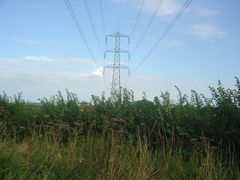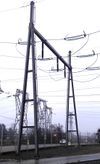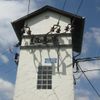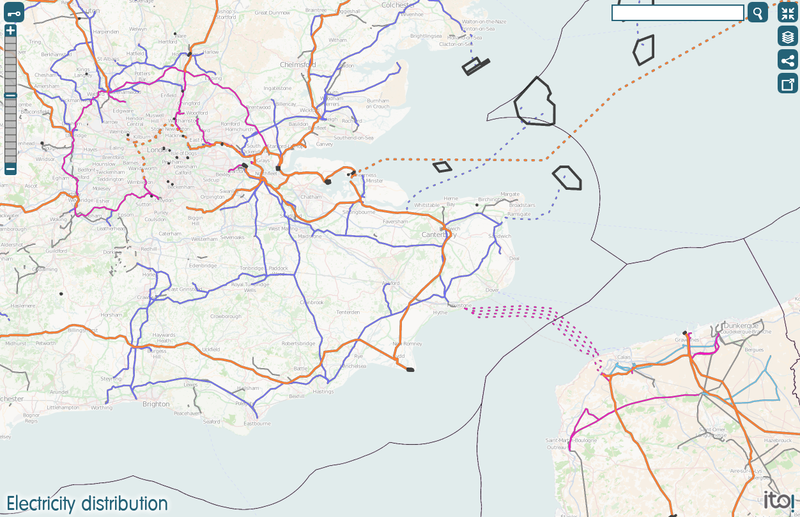Uk:Power

|
| Опис |
| Використовується для опису ліній електромереж та пов'язаної інфраструктури. |
| Теґи |
Теґ power=* використовується для позначення широкого спектра об'єктів, які стосуються генерації та розподілу електричної енергії, включаючи лінії електропередач, об'єктів що використовуються для виробництва електроенергії, електричних опор та підстанцій. WikiProject Power networks містить більш докладну інформацію про проект щодо нанесення на мапу елементів мережі виробництва, розподілу та постачання електроенергії.
Елементи
Електроенергетика
Застосовується для позначення об'єктів або споруд з виробництва і розподілення електроенергії.
| Ключ | Значення | Елемент | Пояснення | Позначка на мапі | Фотографія |
|---|---|---|---|---|---|
| power | cable | Лінія, що позначає місце розташування підземних кабелів електромереж, наприклад кабелі мережі низької напруги 0,4кВ, що зʼєднують підстанцію з трансформаторами та розподільчими шафами, або підводні (морські) кабелі. Не треба плутати з іншими кабельними мережами, наприклад телекомунікаційними. Може доповнюватись теґами voltage=*, circuits=* та location=*.
|
 | ||
| power | catenary_mast | Щогла |
 | ||
| power | compensator | Пристрої живлення, які використовуються для забезпечення якості живлення та стійкості мережі. |  | ||
| power | connection | Окреме електричне з’єднання між двома або більше повітряними проводами |
 | ||
| power | converter | Конвертер – пристрій, призначений для перетворення змінного електричного струму на постійний (або навпаки). |  | ||
| power | generator | Генератор, енергоблок – пристрій, що використовується для перетворення енергії з однієї форми в іншу. Використовуйте в комбінації з generator:source=*, generator:method=* і generator:output=*.
|
 |
 | |
| power | heliostat | Геліостат — оптичний прилад (дзеркало) для відбиття сонячних променів. |  | ||
| power | insulator | Ізолятор – використовується для захисту лінії електропередач від контакту з опорами. |  | ||
| power | line | Лінія електромережі – лінія, якою позначаються повітряні чи підземні високовольтні лінії електромереж. Для позначення низьковольтних ліній електромереж використовується теґ power=minor_line. Корисно додавання додаткової інформації за допомогою теґів voltage=*, cables=* та wires=*. За додатковою інформацією звертайтесь до відповідних розділів Вікі.
|
 |
 | |
| line | busbar | Зазначає, що лінія power=line є шиною на підстанції.
|
|||
| line | bay | Зазначає, що лінія power=line є зʼєднувальним ланцюгом між шиною та вхідною лінією.
|
|||
| power | minor_line | Низьковольтна (повітряна) лінія, що підтримується звичайними стовпами, а не опорами, що використовуються для високовольтних мереж. (Це не так просто, оскільки іноді більші вежі замінюють меншими опорами, зробленими з міцнішого матеріалу; краще все ж базуватися на напрузі.) |  |
 | |
| power | plant | Підприємство енергетики, що генерує певний вид енергії (електричну, тепло, холодну воду, біогаз, й інше). Кожен окремий генератор/реактор позначається за допомогою теґу power=generator.
|
 |
 | |
| power | pole | Опори (стовпи), що використовуються для мереж з низькою та середньою напругою та високовольтних мереж (power=line) до 161 кВольт.
|
 | ||
| power | portal | Тип опор, що складається з двох вертикальних опор між якими знаходяться дроти електромережі та горизонтальної балки, що спирається на них, до яких дроти кріпляться через ізолятори. |  | ||
| power | substation | Електропідстанція – комплекс споруд з розподілення та зміни характеристик електроструму в мережі. Частіше мають вигляд невеликої споруди, але нерідко займають велику територію. Корисно додавання додаткової інформації за допомогою теґів voltage=*, substation=* and location=*. За додатковою інформацією звертайтесь до відповідних розділів Вікі.
|
 |
 | |
| power | switch | Рубильник, вимикач — пристрій для вмикання, вимикання та перемикання електричного струму на лінії. |  | ||
| power | switchgear | Розподільний пристрій складається з однієї або кількох шин та кількох зʼєднувальних ланцюгів bay, кожен з яких з’єднує лінію електромережі з шинами. |  | ||
| power | terminal | Точка підключення повітряних ліній електропередач до будівель або стін. |  | ||
| power | tower | Пілон, башта лінії електропередачі — висотна металева (рідше бетонна) конструкція, яка тримає дроти високовольтних магістральних ліній. Не має використовуватись для позначення стовпів низьковольтних та мереж з середньою напругою, натомість використовуйте power=pole. Ознайомтесь з power=tower для отримання докладною інформації щодо особливостей теґування різних типів високовольтних опор.
|
 |
 | |
| power | transformer | Трансформатор — прилад для збільшення або зменшення напруги змінного струму. Великі трансформатори входять до складу підстанцій. |  | ||
| power | Визначається користувачем | Значення, що широко використовуються відповідно до Taginfo. |
This table is a wiki template with a default description in English. Editable here.
Настанови
Дуже корисно для навігації.
Кількість дротів в кожному кабелі може бути позначено за допомогою wires=single, wires=double або wires=quad. Всі опори також мають один чи більше дротів заземлення, натягнутих зверху.
France
See WikiProject Power networks/France
Germany
See WikiProject Power networks/Germany. The transmission network usually uses steel lattice pylons. There are three voltages:
- 380 kV: mostly triple or quadruple wires, historic lines may have double wires
- 220 kV: mostly double wires, historic lines may have single wires
- 110 kV subtransmission: single wires
Frequently, pylons carry multiple lines even at different voltages to save space.
The distribution network lines operate at 20 kV in most rural regions and are installed on wooden, concrete or small metal poles. 3 or 6 single wires, usually no ground wire. Single remote houses or farmyards may be supplied by 950 V lines of similar appearance.
Power lines showing 4 or 8 cables belong to the railway traction power network operated by DB Energie independently (110 kV two-phase, 16.7 Hz). Mostly single wires, rarely double or quadruple (at same voltage, increasing the possible current load).
Japan
In Japan, see User:Nahainec/PowerLine.
Philippines
Further information at WikiProject Power networks/Philippines
Power lines in the Philippines are operated by various companies and cooperatives. The National Grid Corporation of the Philippines (NGCP) operates both subtransmission (69 and 115 kV) and transmission lines (115 kV, 138 kV, 230 kV, 350 kV DC, and 500 kV), but utilities (e.g. Meralco, Visayas Electric Company, Davao Light) and electric cooperatives may operate subtransmission lines (69 or 115 kV) and distribution lines (usually 7.97/13.8 kV, or 20/34.5 kV). Some electric cooperatives only operate distribution lines, and depend on NGCP (or NAPOCOR-SPUG in areas not yet connected to NGCP grids) for subtransmission lines to feed their substations.
Power line locations may be on allocated right of way or along roads or railroads. Transmission lines usually run on separate right of way, but a few partially or completely running along roads or railroads. Subtransmission lines by NGCP typically run on separate right of way and some segments follow roads, but utility or cooperative-owned subtransmission lines are usually roadside, for easier access by work vehicles. Distribution lines are almost roadside and areas served by the lines are usually served by multiple distribution transformers (single-phase), like the common practice in most of Asia and the Americas. Smaller distribution substations (substation=minor_distribution) are primarily used on large users, like some government offices, malls, or condominiums, instead of a larger area, like residential areas, where multiple distribution transformers are used instead.
Voltages used are like those used in the United States, and the frequency is 60 Hz. The household voltage is 220 volts, 60 Hz, somehow double the 110/220 volts lines once used in the US, before it is raised to 115/230 volts and the current 120/240 volts, though people still refer them as 110 V volts. Standard voltages for power lines, follow this hierarchy, from low to high voltage, and further information can be seen in WikiProject Power networks/Philippines and User:TagaSanPedroAko/Philippines Tagging/Power lines.
Common grid voltages, with usual characteristics, are:
- 220 volts - secondary distribution. Can be two-wire (line and neutral, common in most provinces served by electric cooperatives and other utilities) or three-wire (two 110 V lines with neutral, commonly in areas served by private utilities, especially Meralco).
- 2,800/4,800 volts - one to three wires, carried on 9 meter and above poles. Transformers in these lines has primary bushings on the side of the transformers. This voltage, still used by Meralco, is being slowly phased out (through abandonment of lines or conversion of lines for the 34.5 kV level), to eliminate the need of additional substations or equipment to provide the voltage level to the end customers.
- 7,620/13,200 volts (or 7970/13800 volts, by Meralco, in northern Bulacan, southern Cavite, parts of Laguna, and Batangas City and San Pascual in Batangas) - one to three wires, placed on poles 9 meters or above in height. Lines uses insulators of about 15 centimeters in length. Transformers on such lines usually feature two bushings, but the other bushing is rather part of the grounding mechanism, providing 220 volts directly on two-wire lines. Lines by Meralco, Cabanatuan Electric Corporation (CELCOR), and First Bay Power Corporation (in Bauan, Batangas) use both bushings, thus, they supply 110*2 split-phase voltage. This voltage is most used by most electric cooperatives in the Philippines, as well as by most utilities.
- 20,000/34,500 volts - one to three wires, usually in poles 12 meters and above in height. Lines of these voltage uses transformers with only one bushing, and uses insulators of about 35 or 45 centimeters in length. This voltage is usually used by Meralco, but also used by Cagayan Electric Power and Light Company (CEPALCO) in Cagayan de Oro (though the common voltage used is 7.62/13.2 kV, fed by the 69 kV network).
- 69,000 volts - three-wire system, usually without a neutral, that uses poles 15 meters and above in height, and uses 70 to 75 centimeter insulators (pole mounted, suspension-type, strain-type, and rarely, pin-type). Taller steel poles that are used on 230,000 volt line, however, are rarely used. Considered a subtransmission voltage, and connects to larger customers and the primary distribution systems. Mostly used by the National Grid Corporation of the Philippines, but also used by some electric cooperatives and utilities.
- 115,000 volts - three wire system, with or without neutral, either on poles or towers, and uses 1.2 meter insulators (pole mounted, suspension-type, and strain-type) Usually found in Meralco's coverage area, but also used by the National Grid Corporation of the Philippines, especially its transmission lines that connect to the wind farms in Ilocos Norte.
- 138,000 volts - three wire systems (single or double circuit), on towers or steel poles with insulators of approximately 1.4 to 1.5 meters in length. Considered a regional transmission voltage in Visayas and Mindanao.
- 230,000 volts - three wire systems (single or double circuit), on towers or steel poles with insulators of approximately 2.3 to 2.4 meters in length. Considered a regional transmission voltage in Luzon, but also used in Visayas and Mindanao as bulk transmission voltages (to complement the 138 kV systems there). Lines usually have one conductor, but may be bundled to two, three, or four for additional capacity or efficiency (to mitigate power loss from corona discharges)
- 350,000 volts - two-wire systems (single circuit), on towers. Used on HVDC Leyte-Luzon transmission line, and has triple-bundle conductor (to mitigate power loss from corona discharges). On San Bernardino Strait between Cabacungan in Allen, Samar and Santa Magdalena in Sorsogon Province, Luzon, the line uses submarine cables.
- 500,000 volts - three wire systems (single or double circuit), on towers, or rarely, steel poles with insulators of approximately 5 to 5.1 meters in length. Considered a bulk transmission voltage in Luzon, and has a high carrying capacity, through the use of quadruple-bundle conductor (to provide more capacity and mitigate corona discharges).
Transmission, subtransmission, and distribution grid voltages, however, differ by island group, region, and company/cooperative practice.
- Metro Manila and nearby provinces in Luzon (Meralco):
- Transmission: 500,000 volts, 230,000 volts,
- Subtransmission 115,000 volts, 69,000 volts (northern Bulacan and Batangas City
- Distribution: 34,500 volts/20,000 volts (most of Meralco's coverage area), 13,800 volts/7,970 volts (Batangas City and San Pascual, both in Batangas)
- Household distribution: 110/220 volts (three wire split-phase)
- Most of Luzon:
- Transmission: 500,000 volts, 230,000 volts
- Subtransmission: 69,000 volts
- Distribution: 13,800 volts, 7970 volts
- Household distribution: 220 volts (single phase)
- Ilocos Region:
- Transmission: 230,000 volts, 115,000 volts
- Subtransmission: 69,000 volts
- Distribution: 13,800 volts, 7970 volts
- Visayas
- Transmission: 230,000 volts, 138,000 volts
- Subtransmission: 69,000 volts
- Distribution: 13,800 volts, 7,970 volts
- Household distribution: 220 volts (single phase)
- Mindanao
- Transmission: 230,000 volts (for implementation in the near future), 138,000 volts (current voltage, including the transmission backbone)
- Subtransmission: 69,000 volts
- Distribution: 34,500 volts/20,000 volts (Cagayan de Oro only), 13,800 volts, 7,970 volts
- Household distribution: 220 volts (single phase) (110/220 volts use in Mindanao not known)
United Kingdom
See WikiProject Power networks/Great Britain.
United States
The number of conductors (i.e. single, double, triple) is simply relevant to the current handling capacity, and not more or less likely to be seen for any particular voltage. Similarly, the number of 3-phase circuits (groups of 3 cables) is simply a matter of capacity required, since single-circuit paths are (somewhat surprisingly) much cheaper to construct - the cost of the cables themselves apparently being the most significant factor.
Рендерінг
Шар електромереж на ITO Map показує power=line відповідно до voltage=* (червоний = 400 kV+, пурпуровий = 300-399 kV, блакитний = 200-299 kV, зелений < 200 kV). Нажаль, цей шар більше не доступний на ITO Map

Open Infrastructure Map, показує електричні мережі, об'єкти телекомунікації, водопостачання, нафтопроводи та радіорелейні станції, також представляє лінії електропередач на одному зі своїх шарів, показуються також назви підстанцій та їх найвища напруга, а також електростанції. Рендерінг ліній електромереж схожий на шар ITO Map's.
Ще один приклад візуалізації можна знайти на Flosm.de.
Інша візуалізація для частини України – nadoloni.com.
Стиль MapCSS
Стиль mapCSS для підсвічування елементів інфраструктури в JOSM.

